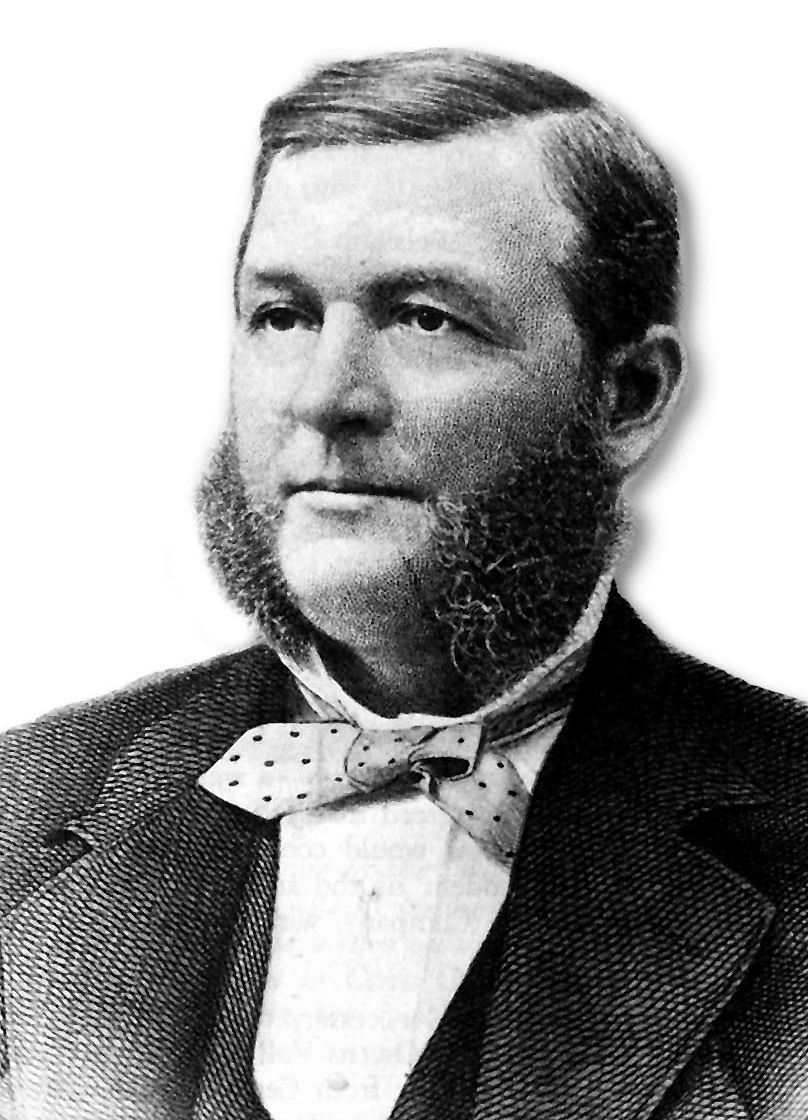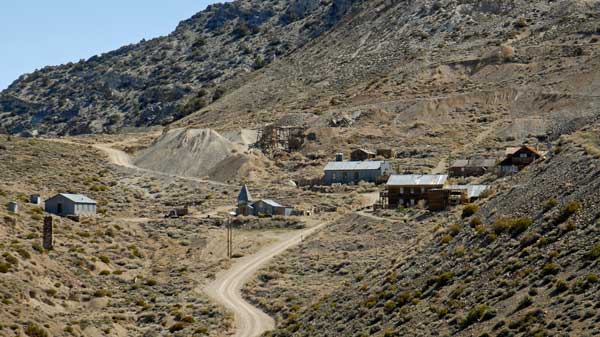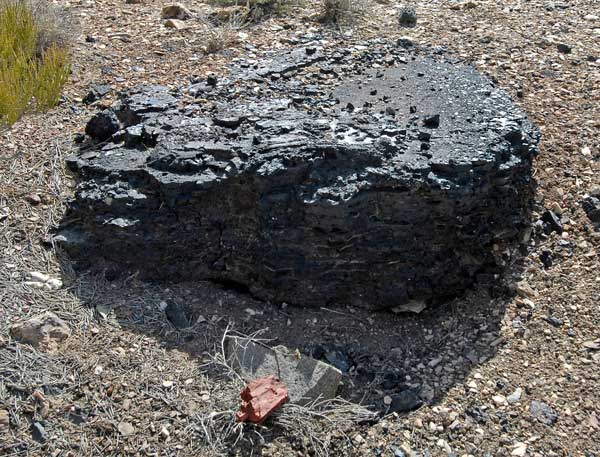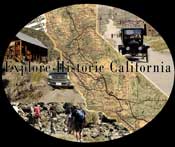Mortimer W. Belshaw was living with his wife, Jane, on
Jackson Street in San Francisco when he heard reports of the
silver strike up on the Fat Hill in the Inyo Mountains
between the
 |
|
Mortimer W. Belshaw |
Sierra Nevadas and present day Death Valley National
Park. After bidding farewell to Jane, and their two sons, he
hopped aboard the stage to the Owens River in the valley of
the same name. Accompanying Belshaw was his friend, Abner B.
Elder.
Belshaw worked, 1862-1864, with silver ore in the mines of
Sinaloa, Mexico. Elder, was also a graduate of the Mexican
mines. Upon their arrival to the primitive camp of Cerro
Gordo in April, 1868, Buena Vista Peak was already
pockmarked from the diggings of Mexican miners who worked
individual sections of the hill. It was said that a big rope
was fastened to a convenient tree in the camp with which
they would hang the first man who talked of “one ledge” to
these men., and the idea of one big “mother lode” was not
even allowed.
Belshaw knew that control of Cerro Gordo would be in the
hands of the man who built the smelting works. As he looked
over the mountain, he saw galena ledges with 40-80 percent
lead content. Knowing these veins would ultimately provide
him control over the workings of the silver ore, he bought
only those deposits containing the galena. The richest
galena load was in the Union Mine, which he managed to
acquire one third interest in from Joaquin Alamada by May 6,
1868.
With visions of building his own smelting furnace in his
head, Belshaw knew it was important to show his wares first.
Using existing Mexican vaso furnaces, he smelted galena into
silver-lead pigs, loaded them into a wagon and drove them to
Los Angeles. Belshaw and his partner, Elder, travelled
through Los Angeles to the San Pedro harbor and created much
excitement with their valuable cargo.
Once at the harbor they loaded their cargo aboard the
steamship, Orizaba and sailed for San Francisco where
they would drove up to the offices of Egbert Judson of the
California Paper Company. Judson liked what he saw so much,
he shook hands with Belshaw and Elder to form the Union
Mining Company.
On the return to Cerro Gordo, it was obvious to Belshaw
that heavy machinery for his own furnace would not make it
up the primitive mountain trail. Through July of 1868,
Belshaw and Elder graded a wagon road the eight miles and
5,000 foot elevation gain from Owens Lake to the mines at
the top of the mountain.
 |
|
View looking east into Cerro Gordo today. The
brick chimney on the left marks the site of
Beaudry's smelter. Belshaw's smelter was at the
top of the road saddle to the left of center.
The original Yellow Grade road is at far right.
The American Hotel, built in 1871 by Belshaw's
competitor, John Simpson, is at the right. The
modern Yellow Grade now winds through the center
of the privately owned ghost town. |
Cerro Gordons joked of having to be drunk to manage the
winding route that consisted of sections so narrow two
wagons could not pass each other without the smaller one
being taken apart so the larger could pass.
Upon completion of this harrowing road, Belshaw saw more
opportunity to leverage control and make money. A toll gate
was set up in the constricted canyon. Every two horse wagon
that passed through had to pay a dollar. A horse and rider
were charged 25 cents. This route, the only practical way up
the mountain, became known as the Yellow Grade, and is the
easier route in to Cerro Gordo today.
The next order of business for Belshaw was to build the
smelter that would extract silver and lead from the galena
ore. His previous experience working in the Pacific Refinery
in San Francisco, and an aptitude for mechanical devices
helped him to design a blast furnace for ore reduction,
complete with a more efficient water jacket.
High on the saddle of the mountains, just below Buena Vista
Peak, the Belshaw smelter was erected. On a shelf
approximately 150 feet wide, the furnace door had a view of
the valley from both sides of the ridge. The blast furnace
itself was two feet in diameter and fourteen feet high.
According to author Robert C. Likes, a 10 horse power steam
engine blower supplied the blast as it entered the furnace
through three cast iron ruyere nozzles, which were located
one foot above the slag spout. The furnace was gradually
heated until the charcoal-filled crucible was aglow, in a
process known as “blowing-in”. Alternating layers of
charcoal, slag, silver ore, sand and limestone were added
from the charge-door.
 |
|
Site of Belshaw's smelter. Only a few scattered
bricks and part of a foundation remain. |
Molten lead and silver were drawn off from the tap hole at
the bottom and poured into bars. At the same time slag
(silica waste) was wheeled out and poured on the dump below
the smelter. With the completion of this furnace, Belshaw
succeeded to efficiently produce silver-lead bullion.
 |
|
A
piece of slag, possibly from Belshaw's smelter,
sits on the ground. Most of Cerro Gordo's slag
was later reprocessed to recover a small amount
of silver. |
By 1871, Belshaw once again drew upon his mechanical
genius, and designed the even more efficient Belshaw Water
Jacket blast furnace. In one twenty-four hour period, this
boiler-like cylinder with scalding water surging between its
double walls and lined with local fire resisting clay, was
capable of producing silver-lead faster than any other
process seen in the United States. In one twenty-four hour
period, 22.7 tons of ore, or 5.25 tons of bullion was
smelted, consuming only 350 bushels of charcoal.
Belshaw joined forces with Victor Beaudry who ran a lesser
smelter a short distance down the mountain. The two gained
almost complete control of Cerro Gordo's ore and bullion
production, earning them both the title of Silver King.
The camp of Cerro Gordo burst with buildings as signs of a
real community, minus church and schools, cropped up. Top
wages of $4 per day were touted by miners. Bullion was
produced faster than it could be carried off the mountain
and shipped to Los Angeles. As others threatened, Belshaw’s
domain, he would battle them, and strengthen his position
buying the remaining shares of the Union Mine and investing
in additional mining properties.
Cerro Gordo would eventually bust in ensuing years, as even
the most productive mining towns are prone to do. Belshaw
would eventually severe his connection with the mines as its
manager, but retain a large financial interest. By 1877, he
arrived in Antioch, Calif., where he opened the Empire coal
mines in the foothills of Mount Diablo. Here along with
Egbert Judson and a man named Rouse, he built a railroad and
dockage, acting as civil engineer and surveyors for the
road.
Near Jackson in Amador County, Belshaw became active in the
Kennedy Mining and Milling Company, as stockholder and
director. He was also acting president of the Gwin Mine
Development Company in Calveras County.
Noted as a man devoted to business and having little time
for leisure, Belshaw spent his later years writing articles
about silver and mining which were published throughout
California. Among the more noted: “Silver on its own Merit”,
San Francisco Evening Post, December 10, 1884; "Hard
Times-Their Cause and Cure”, San Francisco Bulletin,
September 8, 1885; “The Silver Problem”, Winona
Republican, January 4, 1890 and an article entitled
simply “Silver", that was published in Washington D. C,
October, 1893.
Mortimer Belshaw died in the home of his son in Antioch,
Calif., April 28, 1898, following a six month illness. His
wife, the former Jane E. Oxner of Herkimer County New York,
and two sons William Conrad, and Charles Mortimer, succeeded
him.
